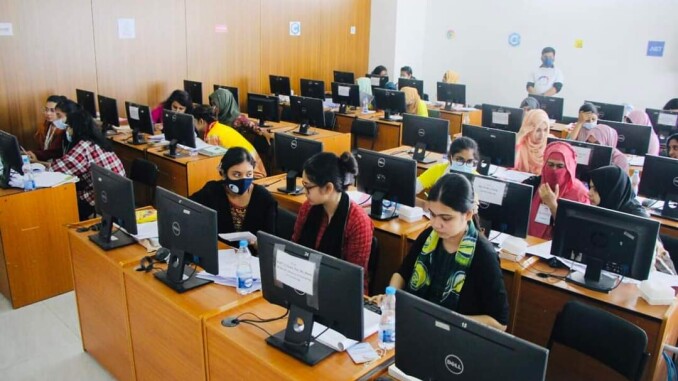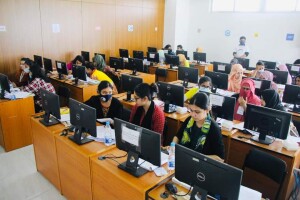
 We conducted a survey on gender based online violence in Bangladesh involving more than 100 female participants to map the prevalence, nature, extent, and effect of gender based online violence (GBV) in the country’s online environment. They survey results is already published in another blog. But prior to this, it has been involved in a research endeavor to see and understand what news media and research report have been saying particularly on this issue. We found some striking similarities and differences on the outcome.
We conducted a survey on gender based online violence in Bangladesh involving more than 100 female participants to map the prevalence, nature, extent, and effect of gender based online violence (GBV) in the country’s online environment. They survey results is already published in another blog. But prior to this, it has been involved in a research endeavor to see and understand what news media and research report have been saying particularly on this issue. We found some striking similarities and differences on the outcome.
- We found in our desk research that the growth of internet penetration and bandwidth redundancy have enabled extensive usage and social media access in the country. For example, there are about 120 million Internet subscribers (BTRC, June, 2021) and 46 million Facebook users in the country. 73% of Facebook users in Bangladesh are at the age group of 13-25, 20% are at the age group of 26-34. Facebook continues to be the most popular social media platform in Bangladesh. We found that to be true in our survey too. In the survey, we found Facebook continues to be the most popular social media channel among female Internet users. Almost 98.1% respondents do have Facebook accounts followed by Instagram (73.1%), YouTube (66.3%), LinkedIn (54.8%) and Twitter (30.8%).
- But what was interesting is that Internet usage hours increased many folded during the pandemic, which has been identified by the desk research and was also validated by the survey. One Internet society report suggests, during the primary stage of the pandemic and the lockdown period, data traffic increased up to 21 percent in Bangladesh. While in the survey, 78.8% of the respondents said that they are using the Internet for more than 4 hours now with some (13.5%) going as much as 12 hours or more a day.
- We knew through our research that the trend for gender based violence on the Internet is growing and that too was reflected through the data found from the Cyber Crime Unit of Police HQ. In the first month to Dec 16, 2021 as many as 5,666 women contacted the special cell, according to the Police Headquarters. Among them, 3,453 contacted through the Facebook page’s messaging option, 3,254 contacted via the helpline and 136 others via email. At least 1,936 of the victims received legal services, 1,796 were asked for permission to use necessary information, while for the rest 1,934 women had or are having discussions with the unit to find a solution. In the survey too, 67.3% of female respondents confirmed that either themselves or their acquaintances have been a victim of ever increasing online crime.
- We also investigated the nature of such online violence and found some similarities in between desk research and survey. Available data found through the Cyber Crime Unit of Police HQ suggests that as many as 1,443 women have complained that their photos or identities or both were used to open fake IDs on Facebook to upload their pictures, videos or information. Also, 716 complaints of social media account hack and 417 incidents of blackmailing were reported. In the survey too, we found that among all the issues, impersonating an user and creating fake profiles using personal data/pictures are the most common complaint (40%). It was followed by the fact that many have been repeatedly harassed by someone online through comments, threats, private messages, tagging, trolling etc (37.1%). Sharing and publishing of private data, conversation, pictures, videos without their consent (24.3%) was also a dominant issue that they faced. Some respondents have also informed that they have received and/or seen lots of hate messages targeted to their identities.(21.4%).
- Our survey gave us some indication on the prevalence of such online violence particularly during the pandemic. There seems to be an increasing trend of online violence during the period of this pandemic. Almost 42% have responded that they or their friends have experienced gender based online violence during this period of the pandemic. This was also supported by another question, where 81.7% respondents suggest that they think (separate from what they experienced) online violence has increased many fold during this period of pandemic when many people were online for various reasons.
- Another important area is preparedness and awareness on cyber security and safety. The increasing trend of domestic violence, online violence, emerging mental health issues etc. during the time of pandemic are not just hearsay, people are experiencing these. But our desk research couldn’t identify the level of digital awareness particularly among female Internet users on online safety, security and legal/administrative and platform centric resources available to counter such issues. Our survey could highlight this a bit. It seems that many of them knew the reporting process of such incidents online and they reported it to the respective social media channels (48.6%). Some even went all the way to report it to the media (15.7%). A small segment (12%) reported it to the police too. A good number of respondents informed that they shared it with their immediate family and friends (34.3%). But there was a small group (11.4%) who kept this hidden from everyone and remained silent. Some (30%) have taken extra protection to safeguard their social media accounts including changing their passwords etc. 25.7% of them have locked their profiles in social media accounts.
- Through our survey, we wanted to see what is the after effect particularly among the female Internet users or the victims of such online crime because this is an area which our research wanted to get some first hand experiences. Our survey gave us that opportunity. A good number of respondents informed that they shared it with their immediate family and friends (34.3%). But there was a small group (11.4%) who kept this hidden from everyone and remained silent. Some (30%) have taken extra protection to safeguard their social media accounts including changing their passwords etc. 25.7% of them have locked their profiles in social media accounts. What is alarming though, some (15.7%) have changed or limited their online activities and 12.9% even have closed their profiles forever in their social media accounts. Some of them (12.8%) don’t share anything via their account. What was interesting to see is that some even have confronted the perpetrator online (8.6%) while many have ignored them (22.9%).
